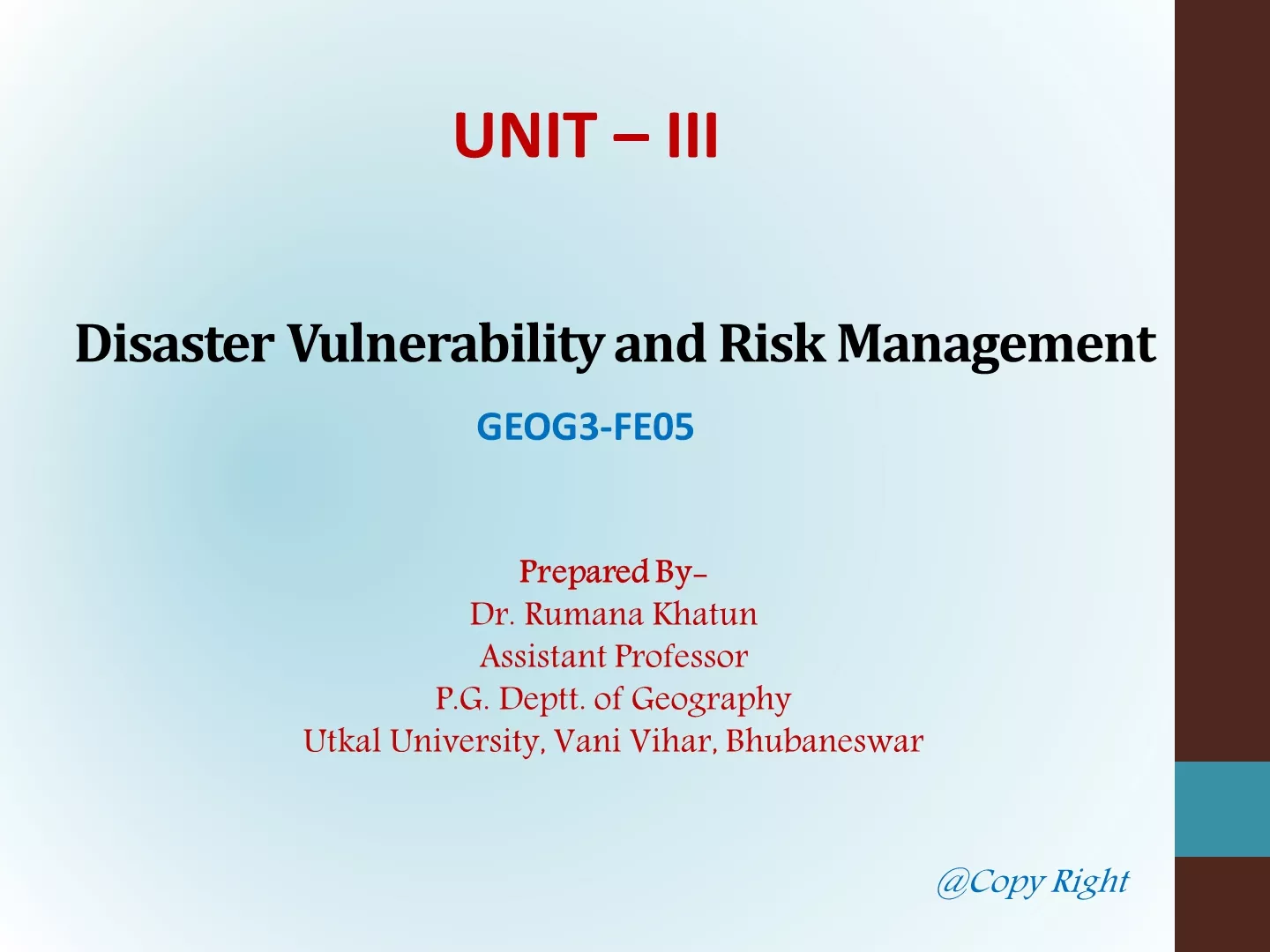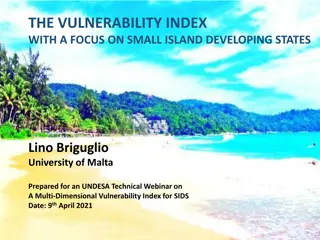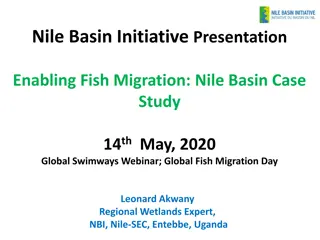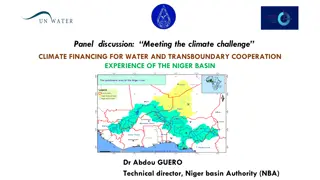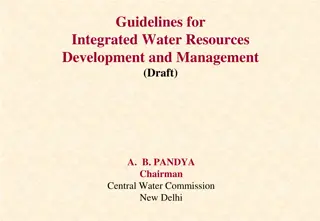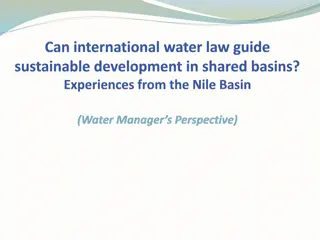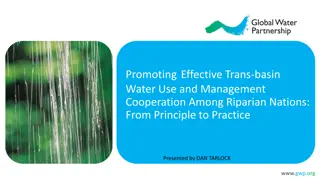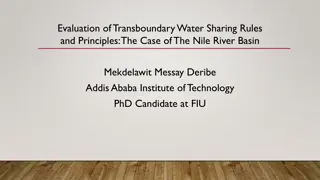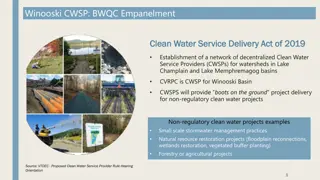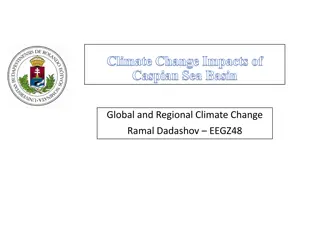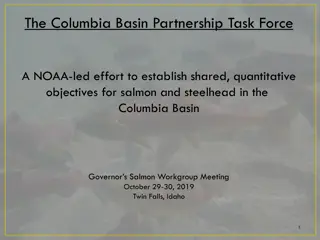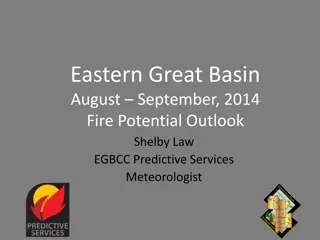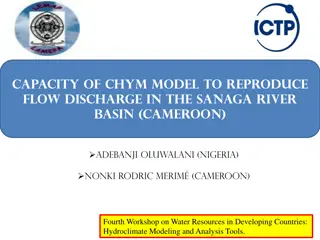Assessing Water Resources Vulnerability in Eastern Nile Basin
Water, a vital natural resource, sustains life on Earth. The limited and uneven distribution of fresh water necessitates assessing vulnerability to enhance positive aspects and address harmful factors. A study evaluates water resources vulnerability in the Eastern Nile Basin, discussing threats and future implications.
Download Presentation

Please find below an Image/Link to download the presentation.
The content on the website is provided AS IS for your information and personal use only. It may not be sold, licensed, or shared on other websites without obtaining consent from the author.If you encounter any issues during the download, it is possible that the publisher has removed the file from their server.
You are allowed to download the files provided on this website for personal or commercial use, subject to the condition that they are used lawfully. All files are the property of their respective owners.
The content on the website is provided AS IS for your information and personal use only. It may not be sold, licensed, or shared on other websites without obtaining consent from the author.
E N D
Presentation Transcript
Water is a prime natural resource, basic need of all living creatures and above all precious national asset. It is one of the most important life-sustaining factors on the earth, the only know planet that supports life Therefore, the fresh water is the elixir for life and this fresh water is limited and unevenly distributed It is of paramount importance to assess the degree of vulnerability of water resources in all related aspects. This will help to enhance the positive factors and mitigate the harmful factors
Vulnerability Assessment of Water Resources System in The Eastern Nile Basin (ENB) Name: Abdel-rahman A. Mustafa Roll No. 9612 Division : Water Science and Technology
In Discussion River Nile Water resources under threat Integrated assessment of water resources The vulnerability concept Indicators as a tool for assessing water resources vulnerability Case study from USA Vulnerability assessment of water in ENB Conclusion Future truth
The Greek word "Nelios", meaning River Valley The world s longest river (6,700 km) From 4o S to 31o N and extends from 21o 30' to 40o 30' E ,traversing 35 degrees of latitude before finally discharging into the Mediterranean Sea Shared among ten countries. Burundi, D.R.Congo, Eritrea,Ethiopia, Rwanda,Sudan, Tanzania and Uganda Egypt, Kenya,
The catchment area about 3.3 million Km2, the home of 300 million people almost of them are among the world s poorest Climate: Mediterranean, to semi arid, arid, subtropical and tropical Topography : very high mountainous areas >5000 m to flat area <159 m below sea level precipitation decreases from above 1000 mm/yr in the southern part to virtually zero in the northern part
Cross-section of the Nile River illustrates the heights from which the Nile originate Source: http://www.mbarron.net/Nile/
(1)the white Nile: originates in a densely populated equatorial plateau agriculture) rainfall varied 1200- 1600 mm Rainfall falls upon equatorial lakes around the world s second largest lake (Victoria ,69,500 Km2) Lake Victoria drains into the Victoria Nile which enters lake Kyoga and lake Albert The flowing out of this lake the river becomes the white river which flows into Sudd (rainfed
(2)The Blue Nile Mediterranean Sea Rises at a spring site upstream of Lake Tana in the Ethiopian highlands The river flows west then north eventually White Nile at Khartoum (3)The Atbara Nile Nile flows northern Sudan it is joined by Atbara, another tributary which originates Ethiopia and Eritrea The Nile then flows into Egypt's Lake Nassar until it meets the Khartoum through the River in
July and October August and October Flows steadily Source: http://www.mbarron.net/Nile
National areas within the Nile Basin % 100 80 60 40 20 0 % Area in Basin % of Basin Area The proportions of basin area within each country and the extent of country contributions to the basin area vary widely (FAO Land and Water Information System,2007)
The variance between export and import of water BCM 150 100 50 0 Actual annual renewable water resources Internal renewable water resources (FAO Land and Water Information System,2007)
Eastern Nile Basin (ENB)
The Britain,Winston Churchill, compared the Nile River with a huge palm tree extending its roots into central Africa in Lakes Kyoga, Albert, and Victoria and its tall trunk to Egypt and Sudan, where its green upper part ends up in north Egypt. If you cut the roots the green upper part will dry out, and the whole tree would die (Churchill, 2000) former prime minister of Great
What is the problem? Hydro-physical considerations Rainfall Highly variable (droughts and floods) (a natural process in the highland areas) Exacerbated by deforestation, high population growth, overgrazing, and use of marginal lands Downstream sedimentation, result in decrease reservoir life, reduce the efficiency of hydropower production and irrigation, erode stream banks, and damage habitat Land degradation lead to (low soil productivity and poor agricultural production) Erosion
Other considerations: Socioeconomic Population growth, urbanization, and industrialization efforts Political factors Political factors (national and on the trans boundary level) Historical
Water scarcity in ENB Population Growth (%) Population 2007 (millions) Projected Population 2025 (millions) Per capita water availability 2007 (m3) Per capita water availability 2025(m3) Country Egypt 1.7 80.3 109.2 1123 630 Sudan 2.1 39.3 56.9 4792 1993 Ethiopia 2.8 76.5 114.6 2207 842 Source: https://www.cia.gov/cia/publications/factbook/
Integrated Assessment of Water Problems in ENB Significant variations between ENB country and many factors influence water resources It is important to consider an integrated approach when assessing water problems water resources systems "Systems" include elements that influence water resources, but are not directly related to it
The six major systems of the anthrop sphere and their major relationships. Individual development Social system Natural Support Human Government system Systems Economic system Infrastructure system Environment & resource system (Bossel , 1999)
The Three Major Systems Influencing the Water Resources System Individual development Social system Natural Support Human Government system Systems Economic system Infrastructure system Water resources system (Bossel ,1999)
Vulnerability The degree, to which a system is susceptible to, or unable to cope with, adverse effects of environmental change Vulnerability of natural and socio-economic system can be determined by the Adaptive capacity on one side and the system s sensitivity on the other (IPCC, 2001 and NERI, 2002) Vulnerable systems/resources Adaptive capacity Low Vulnerable Robust, Inflexible Sensitivity High Adaptive Resilient High Low Combinations of high sensitivity and low adaptive capacity (NERI, 2002)
Water resources vulnerability Reasons Water scarcity Degradation of water resources and environment Capacity problems with respect to institutions, technical issues, and economy Shortcomings and disequilibria within human capacity and political set-up Crucial driving forces behind these pressures Population growth Urbanization and other migrations Changes in climate, environment, and nature Economy and distribution of wealth Human, technological, and industrial development
Vulnerability of water resources systems is multifaceted and is not only related to quality and quantity of water but also to geopolitical and institutional, health and population, hydro-physical infrastructure and management, or socio-cultural and economic (Hamouda et al., 2009) and ecological,
Indicators as assessment tools of water resources vulnerability Help to reflect and communicate a complex idea. They are everywhere and are part of our everyday planning tasks. We use them to observe, describe, and evaluate actual states, to formulate desired states or to compare an actual with a desired state (Seager, 2001 ; WWDR, 2003 ) An indicator, any variable that characterizes the level of vulnerability and/or resilience (Brenkert and Malone 2005) There is significant interest in the use of indicators to assess socioeconomic and environmental status and impacts at the national or regional level (Rogers, 1999)
The Arctic Water Resource Vulnerability Index: An Integrated Assessment Tool for Community Resilience and Vulnerability with Respect to Freshwater (Alessa et al., 2008)
Resilience is a function of both the physical system and the social System AWRVI = [AWRVI physical + AWRVI social]/2 Physical index comprises 5 constituent indices and a total of 17 indicators Social index comprises 4 constituent indices and a total of 8 indicators Resilience Threshold Vulnerability
AWRVI Physical social Natural supply Municipal supply Water quality Permafrost Subsistence habitat Economic capacity Institutional capacity Knowledge capacity Cultural capacity
Natural supply Precipitation Lower rainfall or snowfall & greater variability greater vulnerability than higher precipitation and less variability Surface water Greater surface water and less variability the greater the resilience
River runoff Higher annual runoff and less variability in runoff are more resilient than one with less runoff and greater variability (Lammers et.al.,2001) Seasonal Variation in Water Supply The index will tend to 0; i.e. highly resilient to seasonal water supply changes In contrast, if all of the flow occurred in 1 month, then the value would be very high and this would be highly vulnerable. (Qmax - Qmin)/Qmean Q = monthly river discharge (Lammers et.al.,2001)
Municipal supply Per Capita Water Yield The total combined yield per person per day from wells, reservoirs, tanks, and other human infrastructure (20 100 L per person per day yield is considered resilient ) (Chambers et al.,2007) Water Source Diversity The more sources available to a community, the more resilient that community is (Chambers et al., 2007)
Municipal supply Treatment Technology Scale Municipal water that is treated before delivery carries less health risk than untreated water and so enhances the resilience of a community Similarly, wastewater and sewage that has undergone treatment before being returned carries less health risk than untreated waste and so also enhances resilience Cost Access Source Communities having a water source nearby that requires little energy for extraction are likely to be more resilient than communities with a more distant water source
Quality of water Water Quality Access to good quality increases the resilience, whereas those communities that depend on poor quality water are more vulnerable Water Quality Data
Knowledge capacity Traditional knowledge A community is likely to exhibit greater resilience if a strong cadre of elders are present (Alessa et al., 2008a) Education A community s capacity to respond and adapt is likely to be greater if a high level of education is present in the population This is measured by the number of college degrees per capita (Alessa et al., 2008a)
Knowledge capacity Residency Long-time residents is likely to express a stronger capacity for resiliency because in situ longitudinal information about water sources and changes in those sources provides a stronger capacity for response. This is measured by the number of people with 30 years or more residency in the local area per capita (Alessa et al., 2008a)
Economic capacity A wealthy community can potentially buy themselves out of future problems, relative to a poor community, and is thereby more resilient than the poorer community. The financial wealth, that generated by households in the community, was used (Rose and Liao, 2005)
Rating scale for indicators used in the AWRVI Rating 0.00 Vulnerability resilience description Highly vulnerable 0.25 Moderately vulnerable 0.50 Threshold 0.75 Moderately resilient 1.00 Highly resilient
Physical indicator ratings for Eagle River, White Mountain, and Wales communities, Alaska Index/indicator Eagle river White Mountain Wales Natural supply Municipal supply Water quality Subsistence habitat 0.54 0.80 0.50 0.63 0.33 0.45 0.13 0.63 0.42 0.20 0.25 0.50 Physical Permafrost 1.00 0.00 0.00 Total 0.69 0.31 0.27 Natural Supply sub-index reflects the inherent features of the watershed Eagle River s watershed ( large glaciers and rivers & high snowfall) Both White Mountain and Wales (low snowfall )
Physical indicator ratings for Eagle River, White Mountain, and Wales communities, Alaska Index/indicator Eagle river White Mountain Wales Natural supply Municipal supply Water quality Subsistence habitat 0.54 0.80 0.50 0.63 0.33 0.45 0.13 0.63 0.42 0.20 0.25 0.50 Physical Permafrost 1.00 0.00 0.00 Total 0.69 0.31 0.27 The ability to store, treat, and/or transport water (Municipal Supply) Both the White Mountain and Wales reflect a higher vulnerability than Eagle River, which has a highlyresilient score Highest score in Eagle river followed by White and Wales
Social indicator ratings for Eagle River, White Mountain, and Wales communities, Alaska Index/indicator Eagle river White Mountain Wales Knowledge capacity 0.58 0.75 0.67 Economic capacity Institutional capacity Cultural capacity Total 0.75 1.00 0.25 1.00 0.50 1.00 Social 0.75 0.77 0.50 0.63 0.25 0.54 Eagle River and White Mountain had similar scores reflecting moderateresilience , suggesting that, despite large physical differences, these two communities are similar in terms of the organization of social capital Wales score (0.54) suggests that either social and cultural capital is not optimally organized
AWRVI and indicator ratings for Eagle River, White Mountain, and Wales communities, Alaska Index/indicator Eagle river White Mountain Wales AWRVI Natural supply Municipal supply Water quality Subsistence habitat 0.73 0.47 0.41 0.54 0.80 0.50 0.63 0.33 0.45 0.13 0.63 0.42 0.20 0.25 0.50 Physical Permafrost 1.00 0.00 0.00 Total 0.69 0.58 0.31 0.75 0.27 0.67 Knowledge capacity Economic capacity Institutional capacity Cultural capacity Total 0.75 1.00 0.25 1.00 0.50 1.00 Social 0.75 0.77 0.50 0.63 0.25 0.54
Vulnerability Assessment of Water Resources Systems in the Eastern Nile Basin (Hamouda et al., 2009)
DPSIR Driving force-Pressure State-Impact-Response [DPSIR] Introduced by the Organization for Economic Cooperation and Development (OECD) in 1994. This enables to link between the environmental, economic and social indicators (WWDR, 2003)
A generic DPSIR framework for water Driving forces Response Water use restrictions, Alternative supplies Subsides water prices Voluntary agreements Water research investments Water infrastructure Water reuse Water conflicts Population growth Urbanization Industrial development Agricultural development Geologic and volcanic activities Pressure Climate change Water pollution Water intrusion Human underdevelopment Droughts/floods Water quality deterioration Desertification Water quality Groundwater status Ecological (chemical, Physical, biological) Impact State (Kreistensen, 2004)
A Framework for assessing vulnerability Stage 1: Study objectives & ENB characteristics Indicator selection approach (DPSIR) Stage 2: Indicator clusters& categories Indicator database (Previous studies) Indicators clustering Stage 3: Screening indicators Outlined indicator list Stage 4: Evaluating indicators Final indicator list for the ENB countries Stage 5: Choosing a display method Vulnerability assessment of water systems in the ENB
Geopolitical and Institutional Vulnerability
Egypt Threshold Sudan Threshold indicator of dependence indicator of dependence 5 5 Existence of water quality standards Average ODA for water ($/capita/year) Existence of water quality standards Average ODA for water ($/capita/year) 3 3 1 1 -1 -1 R&D R&D Political stability Political stability expenditure (% of GDP) expenditure (% of GDP) Government effectiveness Government effectiveness Ethiopia Threshold indicator of dependence Geographically, downstream country Its dependence is so high (97%) Less extreme in Sudan Ethiopia TheAfrica s Water Tower being totally Independent Egypt is a 5 Existence of water quality standards Average ODA for water ($/capita/year) 3 1 -1 R&D Political stability expenditure (% of GDP) (Mason, 2003) Government effectiveness
Egypt Threshold Sudan Threshold indicator of dependence indicator of dependence 5 5 Existence of water quality standards Average ODA for water ($/capita/year) Existence of water quality standards Average ODA for water ($/capita/year) 3 3 1 1 -1 -1 R&D R&D Political stability Political stability expenditure (% of GDP) expenditure (% of GDP) Government effectiveness Government effectiveness Ethiopia Threshold indicator of dependence Average Official Development Assistance ODA for water Egypt is better then Ethiopia followed by Sudan 5 Existence of water quality standards Average ODA for water ($/capita/year) 3 1 -1 R&D Political stability expenditure (% of GDP) Government effectiveness


